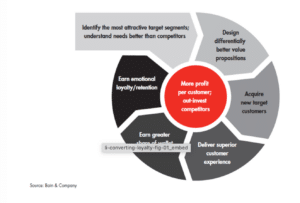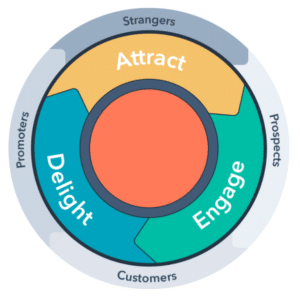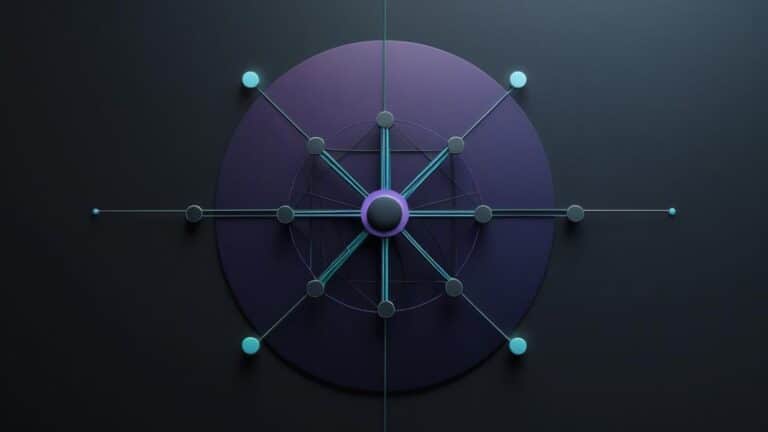With virtual products at the mercy of a mobile swipe and payment options with a quick scan of consumers’ fingerprints, this is the decade of heightened digital experiences. Businesses all over the world, both big and small, are making sure they’re capitalizing on all of the latest tools and technologies available to make the customer experience easier, self-paced, and highly personalized.
So, what’s the catch? Well, for starters, you may wonder, why is customer loyalty important? How do businesses ensure customer loyalty when every other brand is also working on their digital experiences as much as and as fast as you are? What are the customer retention strategies that businesses need to think about in the context of today’s customer preferences?
There’s a lot to consider. Let’s get to some stats to fill the ink of our customer marketing pen. According to a recent article about customer retention statistics from SEMrush:
- 89 percent of companies say that excellent customer service plays a huge role in customer retention.
- The probability of selling to an existing customer is between 60-70 percent.
- The probability of selling to a new customer is only between 5-20 percent.
- The average loyal customer spends 67 percent more in their 31st to 36th month with a brand than in their first six months of the relationship.
- 44 percent of millennials say they are loyal to their favorite brands.
Content marketinghas an effectiveness of 32 percent for customer retention.

B2B marketers emphasize customer retention and loyalty for many reasons. You can sell to repeat customers easily since they already know your brand, and they bring more business through referrals. Besides buying more over time, a loyal client can make high-cost purchases more confidently than a new customer.
Studieshave shown that most companies get 65 percent of their business from previous clients. Further, customer acquisition is about five times costlier than retention. Therefore, your business should employ astute customer retention strategies to maximize ROI.
Content marketing is an excellent way to onboard prospects and convert them into buying customers. However, if you’re creating content exclusively to attract prospective clients, you’re missing out! Investing in the satisfaction of the current customer is essential. You can achieve a 25 to 95 percent profit increaseby improving customer retention by only five percent. Don’t forget: your customer success team needs to know what content is available to them, so they can provide it to customers!
This guide will walk you through different content marketing ideas to gain and clients and reduce customer churn.
Leverage Customer Data to Produce High-Quality Content
Gone are the days of going after keywords with high traffic association and what everyone else is writing about. If you’re not already working with a “pain-point” based content strategyin alignment with SEO, then right now is the time to get started. Internally collected customer data can offer insights into various touch-points and customer journeysthrough every stage, especially the middle and bottom stages of the funnel. These can provide exclusive ideas into what makes the potential customer travel further down the funnel and eventually convert.
Let’s consider an example: Say you have a time tracking software selling to enterprises. Instead of going after high-traffic keywords right away, look at the customer pain points and devise a keyword strategyfrom there. Could the pain points be aligned with some of the long-tail keywords with very specific buying intent? What are those keywords and how can those be incorporated into the content?
Doing this will not only significantly cut down the sales cycle (since only those with very specific buying intent will browse this content), but also create very high conversion rate for content (something that’s still highly misunderstood and underestimated and often unachievable when it comes to content).
Optimize Your Customer Onboarding Process
You may be offering exceptional products and services but face customer attrition due to poor onboarding. Improving the onboarding process is especially vital for complex software solutions that require continuous learning.
Evaluate how customers interact with your software soon after purchase and provide solutions to their pain points. Consider opening a portal that answers your subscribers’ frequently asked questions (FAQs). You may also prepare educational content about your offerings and broadcast it to our users via email.
Regardless of content type, be sure to address the entry barriers that might repel prospects or give your customers an awful experience. If you ask for feedback about your software, users are often happy to provide it. Know how to use data in your marketing strategyto unearth onboarding bottlenecks to improve user experience and build customer loyalty.
Publish Useful Content Regularly
Another best practice for attracting and retaining customers is frequently updating your website with quality content. By so doing, you continuously provide value for your existing customers and stand out as an authority in your niche. It builds trust in your brand and entices clients to extend their subscriptions or purchase more of your solutions.
There are limitless ways of presenting valuable content to your clients and prospects. Starting a blogand generating engaging posts, product descriptions, reviews, FAQs, curated lists, and guides is an amazing option. You can also create podcasts, vlogs, video announcements, and demos for your products.
Set some time aside per week for brainstorming topics and creating content. If you can’t do all the writing, hire a website content writer, or invite guest bloggers to publish on your site. Consider content repurposing into different forms, such as blog posts, infographics, and podcasts.
Target Customers with Customized Emails
With more than 3.9 billion email users, your company cannot afford to ignore the potential of email marketing. It’s an efficient way to reach out to prospective customers and develop relationships with current clients. Email marketing helps you to keep in touch with specific customers.
It’s common practice for businesses to request prospects to join their email lists via subscription forms. Unfortunately, many companies send similar generic emails to both new leads and existing customers. Such messages are often irrelevant and annoying to many clients.
To maintain a personal touch with your clients, take your email marketing campaigns a notch higher with email segmentation. It begins with dividing your customers into categories based on attributes that affect their buying decisions. These can be age, gender, place of residence, and so on.
After splitting up your customer base, target each group with emails that resonate with their interests. Personalized emails show your current customers that you understand and care about them. They inspire clients to buy again from your business.
Build Community Through Social Media
It’s unlikely that your customers are impulse buyers and it’s especially true when you’re a SaaS, tech, or Fintech brand since these conversions are well thought through or only happen when the leadership is in on these buying decisions. This goes beyond the initial awareness phase of understanding their business problems. But you could still build on that. When you build a community around your solutions and have users/leads/customers participate in that conversion on how your solutions are helpful/could be helpful, you’re efficiently removing yourself from their path.
This means that you’re letting them decide on the basis of “established customer loyalty” and newly formed customer base what your products or services can do. Social media especially can be used to push these organic conversations on various platforms.
It could begin with lots of mutual interest small talks (Hey! check out this cool time tracking hack I recently used!), building up to compatibility (is your product or service even relevant to them?) and influence and trust through meaningful conversations (what’s the biggest challenge you’re currently facing? I might be able to offer help), and ultimately continued association as a potential customer (no-strings-attached demo, product guides, podcasts, customer testimonials from the industry they belong to that’ll help them make a buying decision).
Learning Centers – The Customer Retention Strategy Goldmine
Given the chance, most clients prefer self-service instead of calling help desks whenever they have issues. A help center with plenty of customer-centric information is essential for companies offering software products. It enables users to get the most from your solutions, reducing their chances of looking for alternatives.
For your resource center to be useful, it should contain detailed product documentation and how-to guides. You must update it regularly to keep your clients abreast of any developments in your services.
Involve your customer service team when developing a help center since they know the most common queries from users. Be sure to provide comprehensive solutions to questions in your resource center.
Your help center should provide intuitive user experience, or your customers will not use it. A user-friendly interface with a search box guides the user on where to get answers. Providing quick self-service solutions about your offerings can encourage your clients to renew their subscriptions.
Promote Customer Success with Webinars
Webinars are some of the most successful customer retention strategies, with 60 percentof them converting prospects into loyal customers. If you sell relatively complicated software solutions, run live webinars to educate your users on how best to utilize the available features.
Webinars can help your customers to overcome their challenges and discover software functionalities they never knew about. Through customer research, you can learn where your users get stuck. Providing solutions through webinars increases value for your customers, ultimately contributing to retention.
Engage with Your Customers
Creating content for your audience is not enough. You should constantly engage with clients to make them feel appreciated. Ensure there is a way for customers to respond. It can be as simple as comments on your blog posts and social media channels.
Reply to every remark on your posts, and address complaints professionally and on time. How you respond to negative feedback can determine whether the client will do business with you again. Additionally, it can influence the buying decisions of others who come across the conversation.
Revamp Your Customer Retention Strategies
One tactic that drives success in content marketing is content customization. Your approach to an existing customer should be different from nurturing a new lead.
Customer retention requires keeping contact with your clients and assisting them to achieve the best value from your products. Provide them with easy solutions for their pain points for the best user experience.
Incorporate Content Marketing into Customer Retention and Customer Loyalty Strategies
Customer loyalty in marketing can be achieved through the right alignment of content marketing and customer retention strategy. It’s not only a good idea but a total necessity. The combination is an excellent way to maintain customer loyalty without constantly pushing products and services on them or feeling the pressure of up-sell.
We know the buyer journey doesn’t end with them being a customer,nor does the customer experience. Since we’re talking about strengthening customer loyalty as the end goal and not a sale, things like advocacy and retention could be made part of the bottom of the funnel content.

Interesting, right? With the “flywheel” concept, there’s constant momentum of tracing the customer journey, which pretty much goes in a loop. We’re not saying that the funnel is now irrelevant, but it is a sub-set of the flywheel.
You use the funnel to map the buyer journey and use the flywheel to keep the funnel in motion, knowing that there really is no endto how much you can leverage customer experience to convert them into solid brand advocates and loyal fans.
Once your customer retention strategies are aligned with the bottom of the funnel and made part of the flywheel, it’s only a matter of time how fast you can spin it. Each activity you feed into the flywheel becomes a slight nudge into the customer journey towards the action you need them to take.
So, how do you create content that’s in alignment with customer retention?
- First and foremost, set up your resource center and make it super user-friendly so anyone, at any time, can access it and get the answers they need no matter the funnel stage.
- Make yourself readily available to chat with the customer anytime they’re faced with an issue with your product or are looking to learn a feature or two.
- Create engaging content that’s more aligned with what the customers can learn, rather than what else they can buy.
- Ensure content across departments is aligned with the flywheel approach and there’s no piece sitting in silo (goes back to the resource center).
Use cross-collaboration for better content distribution, from customer newsletter and customer loyalty programs to sales enablement, in terms of up-selling.
Contact usto learn more about the customer retention strategies that work best in your niche.




